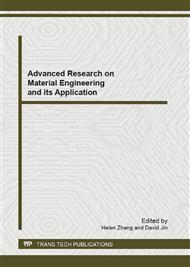p.3
p.7
p.12
p.16
p.23
p.27
p.31
p.35
Preliminary Study on Photocatalytic Degradation of Methyl Orange and Cr(VI) Compound System by Titania-Bearing Blast Furnace Slag
Abstract:
Using calcined sulfate-modified titanium-bearing blast furnace slag (STBBFS) as photocatalyst, decolorization efficiency of methyl orange (MO) in the presence of Cr(VI) were studied. The effect of solution pH on the decolorization efficiency of MO and reduction efficiency of Cr(VI) have been investigated. The results indicate that the acidic solutions are favorable for the photocatalytic oxidation of MO in the presence of Cr(VI), and the optimum pH for oxidation of MO is 1.5. The increasing of photocatalytic activities in the compound system can be attributed to five main reasons: (1) the redox reaction between Cr(VI) and MO; (2) adsorption of Cr(VI) species and dye molecule onto STBBFS surface; (3) the visible light irradiation; (4) Cr(VI) species reduced to Cr(III) by Mn2+ in STBBFS photocatalyst; (5) Moreover, the addition of Cr(VI) species able to act as electron scavengers to catalyst surface promotes the effective separation of electron-hole, and hence promote the increase of decolorization efficiency of MO and reduction efficiency of Cr(VI) in Cr(VI)-MO system under visible irradiation. UV-vis spectral analysis indicated that MO was completely mineralized in the presence of Cr(VI) after 240 min. FTIR spectral analysis showed that all these characteristic peaks of Cr(VI) and MO disappear after photoreaction, indicating the degradation of Cr(VI) and MO.
Info:
Periodical:
Pages:
3-6
Citation:
Online since:
February 2012
Authors:
Price:
Сopyright:
© 2012 Trans Tech Publications Ltd. All Rights Reserved
Share:
Citation:


